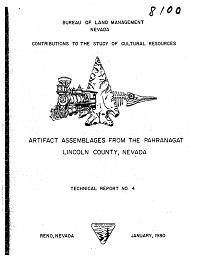Artifact Assemblages from Pahranagat, Lincoln County, Nevada

A major reason for protecting cultural resources is the preservation of a variety of archaeological materials and features representative of the full range of activities of the former inhabitants of an area. A field design to preserve a representative sample of the resource should, therefore, contribute toward a regional inventory from which extrapolation of past cultural patterns may be eventually delineated.
In January, 1979, mitigation procedures were implemented to provide protection for cultural resources located on lands destined to be transferred from public to private ownership.· The subject lands consisted of five closely situated parcels located in Pahranagat Valley of southern Nevada. Of the 130 acres, approximately a 25% sample of the surface area was systematically surface collected of all identified cultural materials. The mitigation effort was designed such that information contributing toward the reconstruction of aboriginal land use patterns in the valley could be obtained.
Nearly 9,000 archaeological specimens, including pottery sherds and lithic items, were collected. The variation in occurrence of material categories with associated natural features suggested a broad array of activities by the aboriginal occupants. Possible activities included quarrying of locally available materials and initial reduction in workshop areas, processing of readily available food resources, and general maintenance activities indicative of habitation. Temporally diagnostic materials strongly suggested a later Southern Paiute occupation and failed to disclose evidence for earlier occupation.
